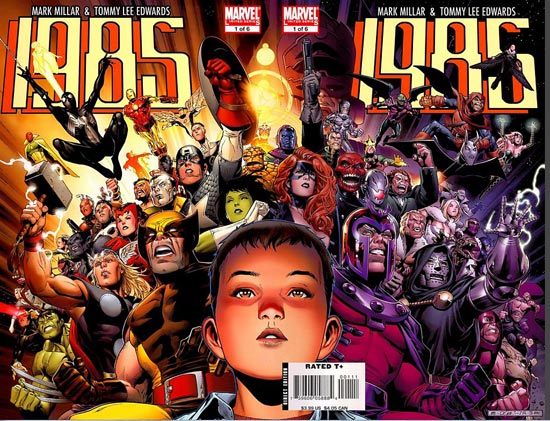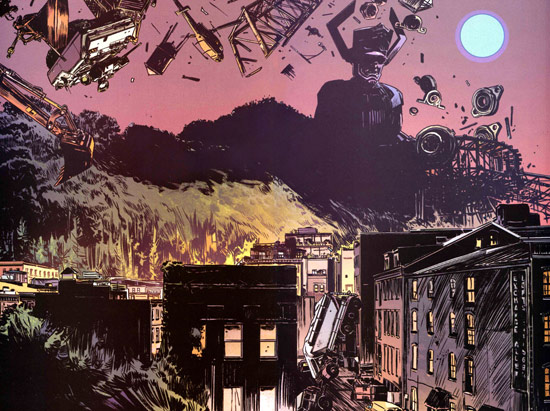Ieder kind dat comics leest, vraagt zich wel eens af hoe de wereld eruit zou zien als superhelden en superschurken echt zouden bestaan. Scenarist Mark Millar geeft in Marvel 1985 het schokkende antwoord.
In het jaar 1985 ontdekt de dertienjarige Toby Goodman dat de superschurken uit Marvel-comics zijn gaan wonen in een oud, vervallen huis bij hem in de buurt. Dat deze figuren geen lieverdjes zijn, wordt al snel duidelijk. Dr. Doom, Dr. Octopus, Electro, Sandman en Juggernaut worden immers niet voor niets superschurken genoemd.
Wanneer ze hun aanwezigheid aan de wereld bekend hebben gemaakt, beginnen ze massaal de bewoners van het stadje Montgomery uit te moorden. Alsof het leven van Toby al niet ingewikkeld genoeg was, met gescheiden ouders en een stiefvader die het gezin naar Engeland wil verhuizen. Ver weg van zijn vader Jerry die, net als Toby, verzot is op Marvel Comics.
1985, een goed stripjaar
Scenaristen als Mark Millar moeten we koesteren. De Schotse schrijver hoort tot het zeldzame soort dat met originele ideeën en bijzondere kwinkslagen het ingedutte genre van superheldenverhalen weet op te frissen. Eerder bedacht hij samen met John Romita Jr. de serie Kick-Ass, waarin een doodgewone tiener besluit voor superheld te spelen, met alle blauwe plekken en gebroken ribben van dien. Ook zo’n interessant uitgangspunt, perfect uitgevoerd in de tekeningen van Romita Jr. Verder loodste Millar de lezer door het ingewikkelde cross-over verhaal Civil War en trakteerde hij de wereld op Wanted.
Samen met tekenaar Tommy Lee Edwards creëert Millar een geloofwaardig 1985, waarin de klappen die de superschurken uitdelen keihard aankomen. In de echte wereld zou geen enkel leger bestand zijn tegen de vernietigende kracht van iemand als Dr. Doom, laat staan dat ze iets kunnen uitrichten tegen Galactus, het buitenaardse wezen dat als ontbijt hele planeten verorbert.
Feest van herkenning
Marvel 1985 deed mij terugdenken aan de tijd dat ik als achtjarige de wereld van Marvel nog maar net ontdekt had en stiekem wel wilde geloven dat je door de beet van een radioactieve spin in staat was over muren te kruipen. Ach, zolang ik een goedgeschreven comic aan het lezen ben, wil ik dat eigenlijk nog steeds geloven. Dat is immers de verdienste van een goede verhalenverteller.
Millars strip is een feest van herkenning voor een stripliefhebber als ik. Niet zo gek dus dat het verhaal begint in een stripwinkel. Ik ken de comic Secret Wars die Toby daar aan het lezen is. Die serie verslond ik indertijd zelf ook. Sterker nog, zonder enige moeite herken ik de door Edwards nagetekende bestaande omslagen die aan de muur van de stripwinkel hangen. Het merendeel van die strips heb ik ooit gelezen.
Spielberg-film
1985 was het jaar dat Back to the Future uitkwam. Films van Spielberg, Joe Dante en Robert Zemeckis toonden een fantasievol en magisch Amerika, waarin buitenaardse bezoekers zomaar een bezoekje brachten aan de voorsteden en waar je naar het verleden kon reizen in een omgebouwde Delorean. Dat de Verenigde Staten in werkelijkheid heel anders bleken te zijn toen ik er een jaar ging wonen, doet niets af aan het feit dat de droomversie van Spielberg en de zijnen voor altijd aan mijn jeugdherinneringen verbonden zal zijn.
Het leuke is dat Marvel 1985 eruitziet en aanvoelt alsof je een Spielberg-film zit te lezen. Het plaatsje Montgomery had prima als decor kunnen dienen in een van zijn films. De kleding van de personages, de houten huizen, main street en het winkelcentrum in smalltown USA zien er precies zo uit als ik me van die films herinner. Net als in de verhalen van Spielberg is de hoofdrolspeler een tiener, een buitenbeentje dat ontdekt dat in de gewone wereld de meest fantastische taferelen kunnen voorkomen.
Tommy Lee Edwards
Veel van de sfeer in de strip is te danken aan de Amerikaanse tekenaar Tommy Lee Edwards. Edwards maakt het contrast met ‘de werkelijkheid’ duidelijk door in de Marvel-wereld alles in lichte kleuren onder te dompelen en geen zwarte vlakken te tekenen. De stripwereld ziet eruit alsof de zon altijd schijnt, alsof alles perfect op zijn plaats staat.
Ook de tekstballoons zijn in de Marvel-wereld mooier afgewerkt dan elders in de strip. De ‘echte wereld’ geeft Edwards vorm met veel zwarte schaduwen en dikke, vloeiende penseellijnen. De gelaatsexpressies van de personages zijn levensecht getekend. De tekeningen sluiten daarmee perfect aan op de weluitgedachte dialogen van Millar.
Met Marvel 1985 hebben Millar en Edwards een vakkundig en geloofwaardig pulpverhaal afgeleverd, dat uitstijgt boven de middelmatigheid die superheldencomics doorgaans kenmerkt.
Deze recensie is gepubliceerd in Pulpman #8.


4 reacties op “Marvel 1985: Originele pulp in een nostalgisch jasje”
[…] Dit blogartikel was vermeld op Twitter door peter te riele, Michael Minneboo. Michael Minneboo heeft gezegd: [nwe blogpost] Marvel 1985: Originele pulp in een nostalgisch jasje http://goo.gl/fb/oqhTw […]
Dit boek moet ik maar eens gaan kopen. Klinkt zeer veelbelovend.
Dave Lizewski is just another ordinary American Teenager: he likes girls (but can’t get a date) and he loves videogames and comic books. One day he has an epiphany. ‘Why hasn’t anyone tried to be a superhero in real life?’ he asks himself, and decides to become one. Dressed up in a green bodysuit and a ski mask and armed with just a pair of batons he calls himself Kick-Ass. After walking around in his suit for weeks without doing anything really, his first act as a superhero is an attempt to stop three loitering hoodlums painting graffiti. They beat Dave into a pulp and stab him. When Dave stumbles into the street, he gets hit by a car. This experience answers his question: nobody dresses up as a superhero in real life because when they do, they get their ass kicked.
In the hospital it takes numerous operations – they fit three metal plates inside his head – and after weeks of recovery and physical therapy Dave is well again. Before we know it, he’s back hitting the streets. After one of his fights ends up on YouTube, Kick-Ass is an overnight success, and more people start to dress up as superheroes. Like the mysterious Red Mist, who seems to steal the spotlight from Kick-Ass, and Dave doesn’t like that one bit. Soon he’ll learn there’s more to Red Mist than he suspects. Of all the hero-wannabees Hit-Girl and her partner in crime Big Daddy seem to be the genuine article. Although Hit-Girl is only ten, she’s a lethal weapon all by herself and soon things get very, very violent when they take on the mafia.
Original ideas
Kick-Ass is the brainchild of comic book writer Mark Millar and artist legend John Romita Jr. Millar is known for ultraviolent comic books that deal withinteresting concepts. In Marvel 1985, a limited series Millar wrote a couple of years ago, the baddies from the Marvel Universe all of a sudden show up in the real world and make havoc. Young Toby Goodman has to travel to the fictional world of Marvel to get help. In Superman: Red Son Millar explores the notion what would have happened if Superman’s rocket landed in Russia instead of Kansas, making him a communist hero. Millar also wrote hits like Wanted, which was turned into a film starring Angelina Jolie, and worked with John Romita Jr. on Wolverine: Enemy of the State.
Romita Jr. is one of the best artists working in the comic book industry today. For the past thirty plus years he’s drawn every major Marvel Comics character including Iron Man, Spider-Man and currently Captain America. Romita is a brilliant visual storyteller: he always puts ‘the camera’ in the right spot and makes sure he presents the story in a clear, exciting way. One can read his comics just by looking at the drawings.
The first Kick-Ass comics inspired a film by the same name by director Matthew Vaughn, but this was not just a carbon copy adaptation. The comic book series had only just begun when the film was being written and shot, so the screen story deviates a bit from the comic book. Which is a good thing, because that way both stories are worth looking into. This summer the sequel Kick-Ass 2 is coming out, and that flick is based on the comics part two and part three in the series, respectively titled Hit-Girl and Kick-Ass 2.
Hit-Girl is a great follow up to the original Kick-Ass comic and deals with the daily adventures of the title character. Although Mindy McCready as Hit-Girl could slice a mafia hoodlum in half with her sword without breaking a sweat, she has a hard time leading a normal life and blending in with her high school classmates. How can she outsmart Debbie Forman, smart-mouthed queen bee of the seventh-graders, if she doesn’t even know what Justin Bieber’s latest album is called and what the hell The Hunger Games are? This is where Dave Lizewski comes in. While Hit-Girl teaches him a thing or two about crime fighting, she learns from Dave what TV series are hip and what songs to put on her iPod.
When Red Mist and the Genovese gangster family try to get revenge on Hit-Girl and Kick-Ass for what they did to the Family in the first comic series, it’s just a matter of time before Mindy and Dave have to suit up once more.
Real-life superheroes
In the third story, Kick-Ass 2, Millar and Romita take the concept of real life superheroes up to a new level when Kick-Ass joins a superhero team. Besides chasing criminals, they also consider more mundane actions such as distribute blankets to the homeless and volunteer at a local hospice. (Stuff we never see DC Comics’s Justice League do.) This shows that Millar is really into tabs on the real-life superhero thing, which is a phenomenon that exists for real in the United States: people dress up as superheroes not so much to fight criminals but to help homeless people or volunteer to help other people in need.
Since Kick-Ass 2 is a comic book, soon things get really ugly and violent when Red Mist, now calling himself The Motherfucker, wants to be the biggest supervillain known to men. He and his group of hired thugs start a violent rampage targeting Kick-Ass’s family and friends and they leave a nasty, bloody trail of victims.
The Kick-Ass stories are a wonderful, satirical take on the superhero genre, with a lot of humorous nods and winks at the comic book scene and contemporary popular culture. The humour makes the ultraviolent action sequences digestible for most readers. However, I had the feeling that in Kick-Ass 2 the creators went a bit overboard when for no particular reason the Motherfucker shoots a bunch of kids and adults in a quiet street in the suburbs. Although the depiction of violence has always been a big part of the story in the series – for example: when the mafia in the first series interrogates Dave they torture him and electrocute his scrotum – in Kick-Ass 2 the violence seems even harsher, even more in your face than before and this time it’s presented with little humour to lighten things up. I would say this kind of satire is probably not for the faint of heart.
Still, the artwork looks great, and on the whole, the Kick-Ass series is definitely worth reading for anyone who loves superheroes or likes to take a piss at dressed-up comic book characters. Needless to say: I am looking forward to the third series and the upcoming movie.
This review is published on the ABC blog.
Lees ook:Marvel 1985: Originele pulp in een nostalgisch jasjeInterview John Romita Jr.: Van Spider-Man tot Kick-AssMark Millar: ‘Kick-Ass is een liefdesbrief’Review X-Men: Ghosts by Chris ClaremontKick-Ass: De film is goed, de strip is beter
[…] Marvel 1985: Originele pulp in een nostalgisch jasje […]